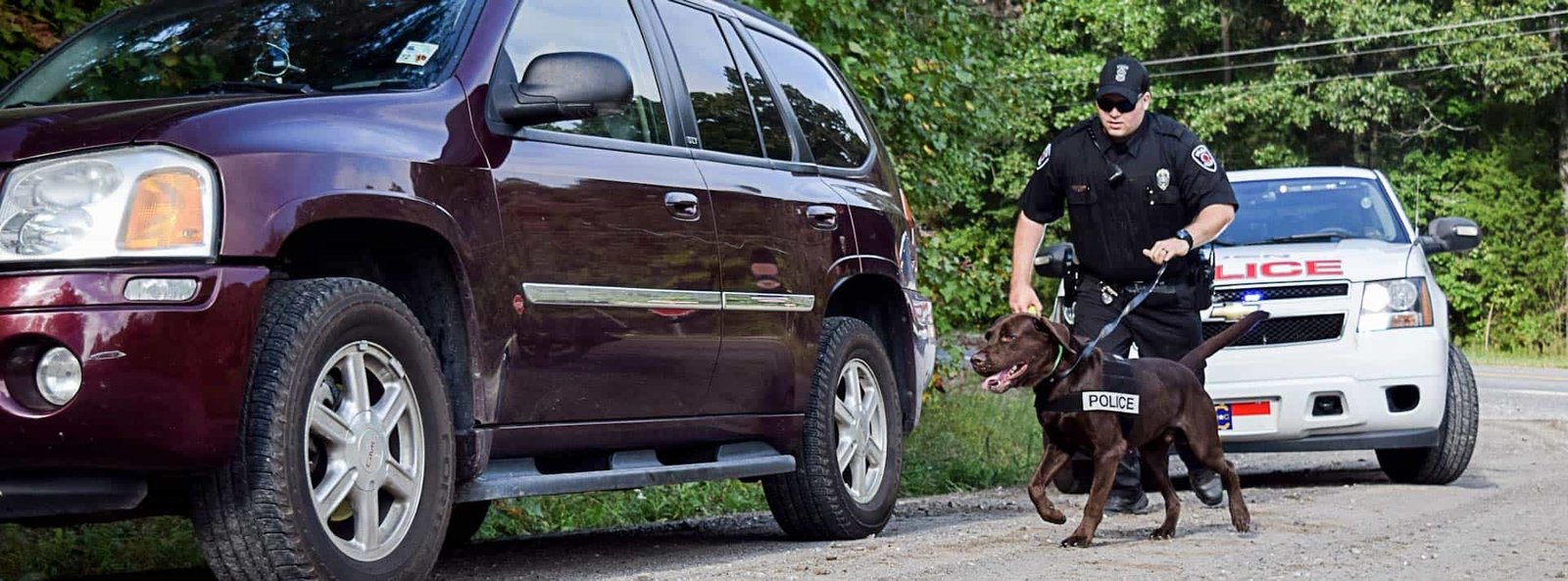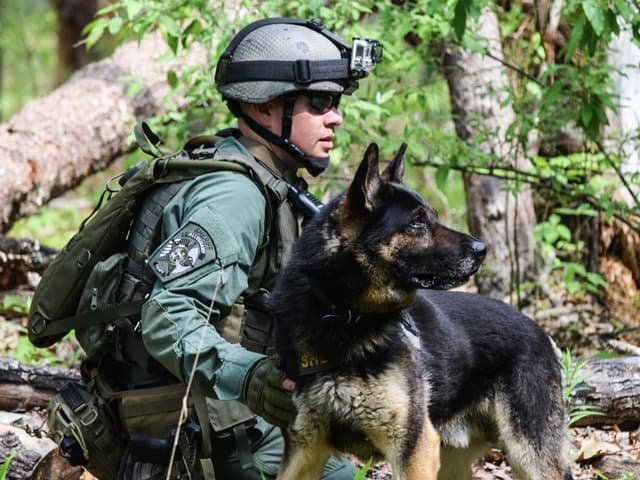Table of Contents
In “The Ultimate Q&A on Police Dogs,” Highland Canine Training aims to provide the general public with accurate information about police dogs and their crucial role in law enforcement. With the rise of misinformation on the internet and social media, Highland Canine Training has compiled a list of common questions and answers to help people gain a better understanding of these incredible canines. From learning about the tasks police dogs perform to understanding the breeds that make the best police dogs, this article offers a comprehensive guide to the world of police K9s.
What do police dogs do?
Police dogs play a vital role in assisting law enforcement officers in various tasks. They are highly trained and skilled in areas such as drug detection, explosive detection, suspect apprehension, and search and rescue missions. Police dogs are trained to use their keen sense of smell, agility, and obedience to aid police officers in their duties, making them an invaluable asset to law enforcement agencies.
Drug Detection
One of the primary tasks of police dogs is drug detection. These dogs are trained to sniff out the scent of various illicit substances, including narcotics, such as cocaine and heroin. Their powerful sense of smell allows them to locate hidden drugs, even in small amounts or concealed compartments. Police dogs assist in drug seizures, helping officers identify and apprehend individuals involved in drug trafficking.
Explosive Detection
Another crucial role of police dogs is explosive detection. These highly trained canines are capable of detecting the scent of explosives and explosive components, helping officers locate and disarm potentially dangerous devices. Whether searching for explosives in a building, vehicle, or open area, police dogs play a vital role in ensuring public safety and preventing acts of terrorism.
Suspect Apprehension
Police dogs are also trained to apprehend suspects. These dogs are often used in situations where officers need assistance in apprehending an individual who may pose a threat or attempt to flee. With their strength, speed, and ability to track scents, police dogs can quickly locate and subdue suspects, assisting officers in safely apprehending individuals.
Search and Rescue Missions
In addition to their roles in law enforcement, police dogs are also frequently involved in search and rescue missions. These dogs are trained to locate missing persons, whether it be in wilderness areas, collapsed buildings, or disaster zones. Their keen sense of smell and agility make them highly effective in finding individuals who may be lost or trapped, helping to save lives in critical situations.
Which breeds make the best police dogs?
When it comes to choosing breeds for police dogs, certain breeds are commonly selected for their specific qualities and traits. The following breeds are known for their suitability in police work:
German Shepherd
German Shepherds are one of the most popular and versatile breeds used for police work. They are highly intelligent, trainable, and possess a strong work drive. German Shepherds are known for their loyalty and protective instincts, making them excellent choices for tasks such as suspect apprehension and search and rescue missions.
Belgian Malinois
Belgian Malinois is another breed commonly used in police work. They are known for their high levels of energy, endurance, and intelligence. Belgian Malinois are often used in roles such as drug and explosive detection, as they have a keen sense of smell and an ability to focus on tasks for extended periods.
Bloodhound
Bloodhounds are renowned for their incredible sense of smell. They have the ability to track scents over long distances and are frequently employed in search and rescue missions, especially when locating missing persons. Bloodhounds are calm, intelligent, and diligent, making them excellent partners for handlers in demanding search operations.
Labrador Retrievers
Labrador Retrievers are known for their friendly demeanor, intelligence, and adaptability. While they may seem more relaxed compared to other police dog breeds, they excel in roles such as drug and explosive detection. Labradors have a strong sense of smell and a desire to please, making them highly effective in working alongside law enforcement officers.

What traits make a good police dog?
A good police dog possesses a combination of specific traits that make them well-suited for their role in law enforcement. These traits include:
Strong Work Drive
A police dog must have a strong work drive, which includes a natural instinct and desire to perform tasks and work alongside their handler. A strong work drive ensures that the dog is motivated and focused on completing their assigned duties, even in challenging or high-pressure situations.
Obedience and Trainability
Police dogs must be highly obedient and trainable. They should be responsive to commands from their handler, whether it be for obedience, search tasks, or suspect apprehension. Trainability is essential to ensure that the dog can quickly learn and adapt to new skills and tasks required in their law enforcement duties.
Sociability
Police dogs need to be sociable and able to interact with different people and environments. They should have a stable temperament and be comfortable working in various situations, such as crowded areas, loud noises, and stressful environments. Sociability enables police dogs to work effectively alongside their handlers and other law enforcement personnel.
Courage and Bravery
Courage and bravery are vital traits for police dogs, especially in tasks such as suspect apprehension. These dogs should possess the confidence and fearlessness needed to confront and subdue individuals who may pose a threat to officers or public safety. Courageous police dogs are an essential asset in ensuring the safety and protection of law enforcement personnel.
What can police detection dogs smell?
Police detection dogs are trained to sniff out a wide range of specific scents based on their intended role. These scents can include:
Drugs
Police dogs trained in drug detection can detect the scent of various illicit substances, such as cocaine, marijuana, heroin, and methamphetamine. These dogs are capable of detecting even small amounts of drugs hidden in vehicles, luggage, or buildings.
Explosives
Explosive detection dogs are trained to detect the scent of explosives and explosive components. They can identify different types of explosives, such as TNT, C4, and homemade bombs. These dogs play a critical role in preventing acts of terrorism and ensuring public safety at airports, transportation hubs, and other high-risk locations.
Human Scent
Search and rescue dogs are trained to track and locate the scent of humans, both alive and deceased. These dogs can locate missing persons, whether it be in wilderness areas, disaster zones, or collapsed buildings. The ability to detect human scent is a crucial skill that enables these dogs to assist in finding individuals in various search and rescue scenarios.

How are police dogs trained?
Police dogs undergo extensive training to prepare them for their roles in law enforcement. The training process typically involves the following stages:
Obedience Training
The first stage of training for police dogs involves obedience training. This includes teaching the dogs basic commands, such as sit, stay, come, and heel. Obedience training establishes a strong foundation for future training and ensures that the dog has a good understanding of how to respond to their handler’s commands.
Sociability Testing
Police dogs must undergo sociability testing to assess their temperament and ability to interact with people and other animals. Dogs with stable temperaments and a friendly nature are better suited for police work, as they need to work alongside their handlers and interact with the public in various situations.
Agility and Endurance Training
Police dogs undergo agility and endurance training to build their physical fitness and stamina. This includes exercises such as obstacle courses, long-distance running, and jumping. Agility training helps dogs navigate different terrains and obstacles they may encounter during search and rescue missions or suspect apprehension.
Specialty Training
Once the dogs have completed their initial training, they receive specialist training based on their intended role. This can include training in drug detection, explosive detection, suspect apprehension, or search and rescue. Specialized trainers use specific scent samples, target odors, and training aids to teach the dogs to recognize and respond to specific scents or situations.
Handler Training
In addition to training the dogs, police dog handlers undergo training to learn how to effectively handle and work with their assigned canine partners. Handler training includes learning how to give commands, interpret the dog’s behavior, and maintain a strong bond and effective communication with their canine partner.
When were police dogs first used?
The use of dogs in law enforcement can be traced back to ancient times, with stories indicating their utilization in various capacities. In terms of organized police dog programs, Belgium is credited with introducing the first program in 1899. In the United States, police dogs were first introduced in New York City in January 1908.

How many police dogs are there in the United States?
Though there are no official figures, it is estimated that there are in excess of 50,000 police dogs in the United States, as stated by Jim Watson, secretary of the North American Police Work Dog Association, in 2010. These dogs serve in various law enforcement agencies across the country, assisting officers in a wide range of tasks and operations.
How long does it take to train a police dog?
The duration of police dog training varies depending on the specific training program and the desired skill set for the dog. At Highland Canine, our police dog training program typically takes 16 weeks to train the dog, with an additional four weeks to train the handler. The training process involves rigorous exercises, practice sessions, and assessments to ensure that the dogs are proficient in their assigned tasks.

Where do police dogs live and where do they sleep?
The living arrangement for police dogs can vary depending on several factors, including the dog, the handler, and local regulations. Some police dogs live with their handlers in their homes, where they are considered part of the family. This close bond and constant interaction with the handler help strengthen the working relationship between the dog and the handler.
However, in some cases, departmental regulations may prevent police dogs from living with their handlers due to various reasons, such as safety concerns or specific policies. In such cases, police dogs are usually provided with appropriate kennel accommodations, where they are cared for by trained personnel. These kennels are designed to provide a comfortable and safe environment for the dogs, ensuring their well-being and readiness for duty.
When do police dogs retire?
Police dogs typically retire from service when they are around seven or eight years old. The retirement age can vary depending on the dog’s health, physical condition, and overall fitness. After years of dedicated service, these dogs deserve a well-deserved retirement.
Retired police dogs are often adopted by their handlers, as there is a strong bond and familiarity between the two. In some cases, retired police dogs may be adopted by other law enforcement officers or individuals who can provide a suitable home and continued care for these loyal and hardworking canines.
In conclusion, police dogs play an integral role in modern-day law enforcement. With their specialized training, keen senses, and strong work drive, these incredible canines assist police officers in various tasks, including drug detection, explosive detection, suspect apprehension, and search and rescue missions. Their dedication and loyalty make them valuable assets to law enforcement agencies, ensuring public safety and aiding in the pursuit of justice.




